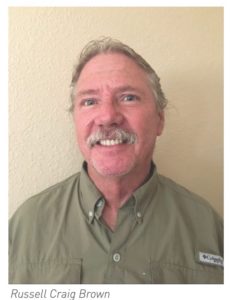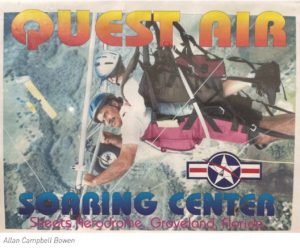Russell Brown and Campbell Bowen
Campbell Bowen and Russell Brown are inextricably linked with the development of aerotowing hang gliders in the way we know it today. Towing hang gliders with boats had been fairly well established by 1986, but the limitations were obvious, especially to Campbell. He was much more interested in the possibility of being towed up under a cloud than simply being dragged along over water. Toward that end, Russell and Campbell, along with 2003 Rogallo Hall of Fame inductee Bobby Baily, modified the airfoil of a two place Advanced Aviation Cobra Ultralight, hoping to achieve the lower towing speeds compatible with hang gliders. They selected an airfoil similar to an NACA airfoil originally created by Nikolai Joukowsky in 1912. This high lift, low speed airfoil was a test airfoil that may not have even been used on any aircraft, as aviation was more interested in high speeds. They found this airfoil in a Sport Aviation magazine laying on the shop room floor when they were working on this problem! Using existing technology with an eye toward simplicity and ease of construction, the trio eliminated the scalloped trailing edge of the Cobra, and incorporated ailerons below the trailing edge, which directs the airflow over the aileron, allowing them to fly safely at lower speeds without losing control authority.
Russell and Campbell were more than pleased with the results, thinking that now everyone in the club could be easily towed to altitude. But to do it safely would require more. From their experience with sailplanes, Russell and Campbell knew that the tug pilot was potentially vulnerable to losing control if the hang glider pilot got too far out of position behind the tug. On their first prototype tug they developed the mast and bridal system to keep the pilot in tow from overpowering the tug in pitch. But even more important was making it easier for the tug pilot to quickly release the glider if it was too far out of position. Existing sailplane release systems required the tug pilot to actuate an awkward, nearly impossible to reach release lever on the floor of the tug. The cure for this was to put the release on the stick—a simple innovation that is in use on all tugs today.
Early flights behind the tug were foot launched, including the first tandem flight by Russell and Bobby. At one point Campbell literally ran out of his shoes, so more innovation was needed. Using the inspiration of a cart designed by Mike Plescovich for taxiing gliders on the field, Bobby designed a new cart (or “launch dolly”) with a new set of castering wheels. The design proved so successful that even the Australians, who initially dismissed the cart as a “baby carriage,” soon adopted its use. Other innovations to the cart came quickly, as they added an adjustable post for setting the glider’s angle of attack and handles for the glider pilot to easily release the cart.
Another innovation created by Russell and Campbell was the over under harness. In the early days tandem flights were being done side by side. In the side by side configuration, you always ran the risk of your student overpowering the instructor. There is much less risk of the student overpowering the instructor with the over under harness. They prototyped the harness using a couple of harnesses they had and sewing webbing in appropriate places. When hanging in their prototype while testing, they broke the beam they were hanging from and both fell to the ground with Campbell breaking Russell’s fall!!. After adjusting everything, they took it to a rigger for proper sewing and the over under harness has become a primary tool for our style of training in the US. As the student is advanced the pilot shifts to the lower position with the instructor shifting to the top.
Using what they learned from cart design, Campbell and Russell developed landing gear for tandem gliders, placing the wheels in front of the control frame to increase safety on soft fields. They also incorporated spring action in the gear, allowing the gear—not the glider—to absorb energy on landing. This gear was later adapted to solo gliders. The objective of the landing gear modification was to not allow the glider to beak or nose over on landing.
Over and under tandem instruction as it exists today has been made possible with Russell and Campbell’s contributions. The limitations of horse power available on the early tugs led to flights so near stall that both tug and tandem pilots were vulnerable, and instructional flights were limited to the calm air of early morning or evening.
Campbell and Russell realized the need for more power on the tug and after trying a couple others, selected the 914 Rotax and got it to work on the Dragonfly. The larger, heavier engine required reengineered engine mounts, as well as moving the engine forward—no small task. They did this for themselves but when others saw it, they liked it so much Bobby had to start making them for others!
With the more powerful engine on tugs, after adjusting tow points and experimenting with weak link strengths at both the tug and the glider, more tandem instructional flights can now be safely done throughout the day within reason.
Much of what Russell and Campbell contributed to our sport was the result of collaboration with Bobby and many others, but it is no exaggeration to say that contemporary industry best practices have their fingerprints all over them. From the proper lengths of tow lines, weak links, releases, bridals, carts, landing gear, and stabilizing fins on gliders to best practices for both tug pilots and tandem pilots, Russell and Campbell have made possible aerotowing as we know it, and opened up flatlands to soaring hang gliders. Thanks to their work, Florida is now a mecca of recreational and competitive hang gliding, and flight parks all over the world have opened the skies to previously inaccessible soaring areas. They have made many selfless contributions, always with the desire to see more people enjoy flight (which they love) safely.
With our sincere thanks for their many contributions, it is our great pleasure to induct Campbell Bowen and Russell Brown into the Rogallo Foundation Hall of Fame.




